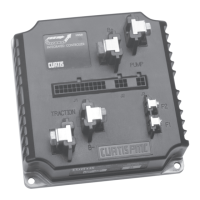Curtis PMC 1297 Manual
32
If the interlock override feature is desired, you will probably want to
configure M2 (mode switch closed) as the slow speed mode, and M1 (mode
switch open) as the high speed mode. This is opposite of the typical setup. NOTE:
The interlock override feature and the high speed latch parameters are mutually
exclusive; you cannot have both.
To initiate override, close the mode switch (M2) while the vehicle is
stopped with the interlock switch open.
To resume normal operation, the interlock or KSI must be cycled.
LOAD COMP
The load compensation parameter actively adjusts the applied motor voltage
as a function of motor load current. This results in more constant vehicle speeds
over variations in driving surface (ramps, rough terrain, etc.) without the vehicle
operator constantly adjusting the throttle position; it also helps equalize loaded
and unloaded vehicle speeds. The load compensation parameter is adjustable
from 0 to 25% of the controller’s PWM output. High values will cause the
controller to be more aggressive in attempting to maintain vehicle speed.
However, too much load compensation can result in jerky vehicle starts and
speed oscillation (“hunting”) when the vehicle is unloaded.
The load compensation parameter is tuned as part of the vehicle perfor-
mance adjustment process (Section 5).
3
A
— PROGRAMMABLE TRACTION PARAMETERS: Speed

